Blog
May 18th, 2010
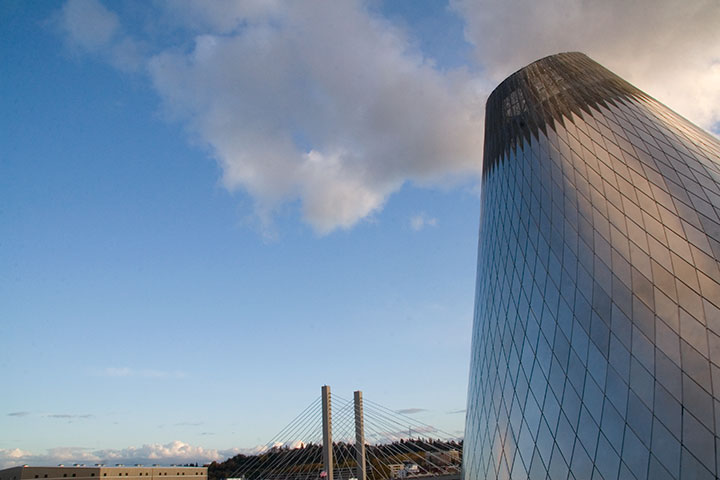
I’ve had volcanoes on the brain for nearly two years. Littering my studio are volumes of sketches, nearly 6,000 photographs, reference books, stacks of maps, and a brand new, functional prototype of the artist book about Mt. Rainier I’m working on—all evidence of my attempts at capturing a series of fleeting moments and freezing them in time and on paper. (Rainier is hiding there in the clouds, at the bottom of the above photo—but what I love most is that the cone looks like an erupting volcano! And speaking of which…)
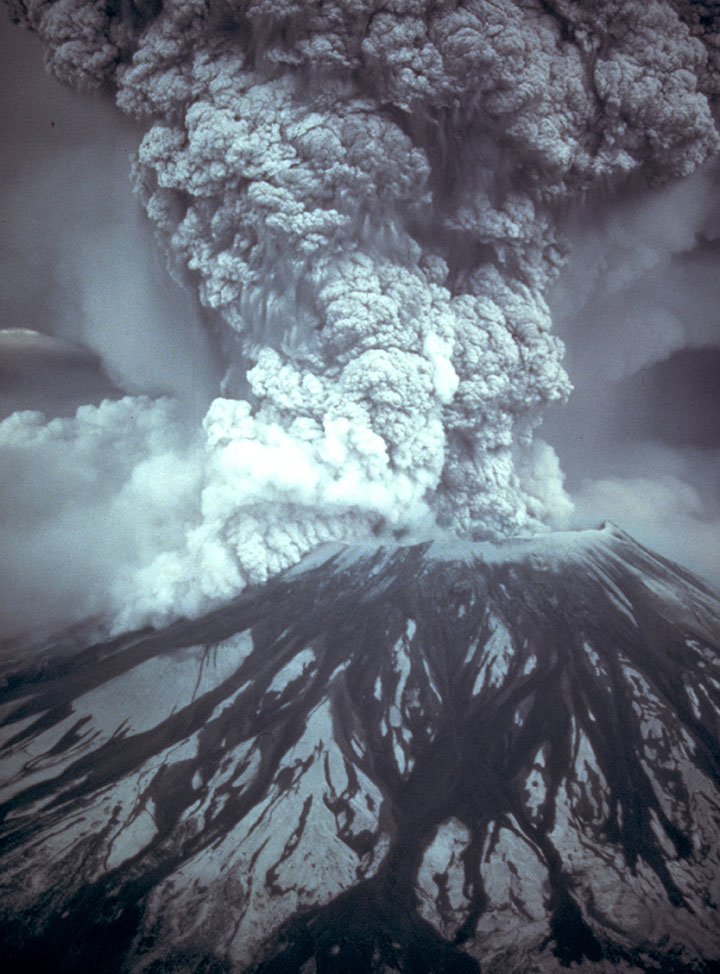
Photo by the U.S. Geological Survey
And then there’s the little corked bottle of volcanic ash on my desk, inscribed with the date of the last major eruption of Mount St. Helens: exactly thirty years ago today.
I’ve been staring at that bottle on and off, all day, reminded of why I’m doing all of this (and why I can’t wait until I have something to show you!).
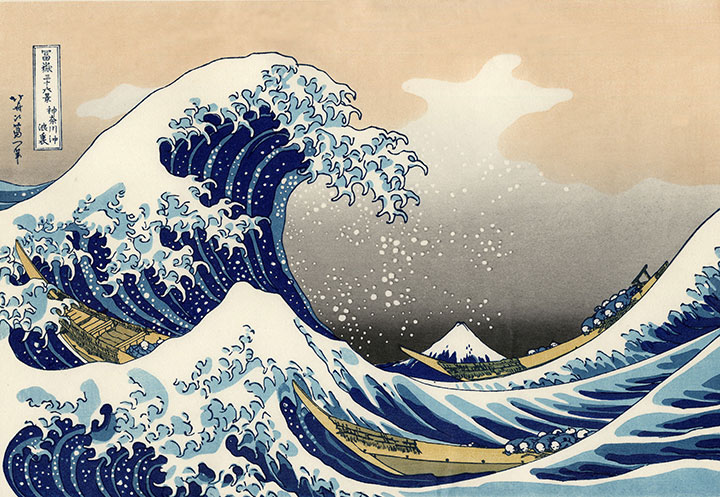
This project began as a tribute to Katsushika Hokusai, the Japanese printmaker and illustrator who created his famous Views of Mount Fuji woodblock series over 150 years ago.

Hokusai wanted to demonstrate the unchanging immortality of Fuji amidst the transient nature of everyday life. To him, Fuji was forever, an unshakable icon of Japan and one of the foundations of his culture.
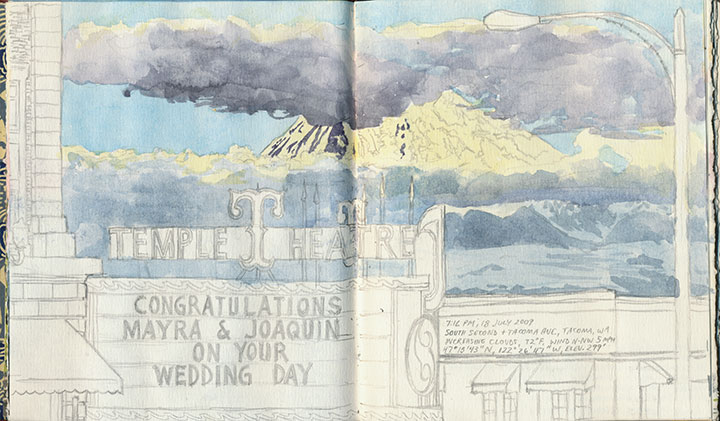
The trouble is, Fuji is a volcano—just like Rainier and St. Helens—that by its very nature is constantly changing right along with the lives being lived in its shadow. That knowledge is where I found the root of my own project, and since then I’ve tried to document the fire mountain in my own back yard—to be there for every change and permutation.

Today’s date lit a bit of a fire under me, and prompted me to get on with the business of finishing this artist book. Because one day this is all going to happen again. Mount Saint Helens will be first, I’d wager; being the most active and youngest volcano in the Cascades, it may only be a matter of a few years. And some day, even if it’s a hundred or a thousand years from now, Rainier is going to have its turn, too.
For now, though, I’m just doing my best to pay attention to the present moment, because one day I may need help remembering how things used to be.
May 15th, 2010

Tomorrow is the first day of the 64th annual National Stationery Show in New York City, the largest paper goods trade event in the country. Around 1300 exhibitors and 15,000 national and international retailers will be there, and my friend Allison Chapman will be showing off her Igloo Letterpress products in her own booth!
Among Allison’s impressive collection of cards and paper goods will be these newest additions to our collaborative greeting collection.
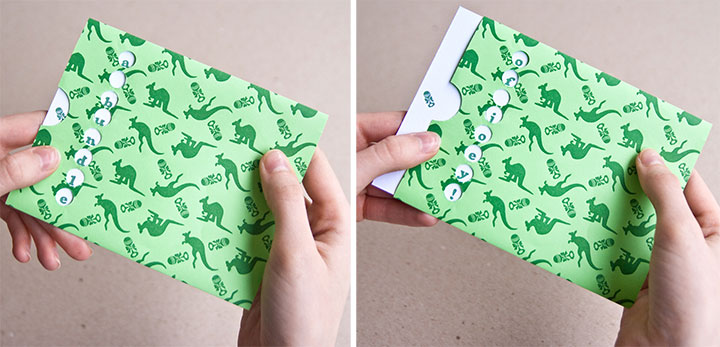
(This pun is all my fault, I’m afraid. I know, I deserve to go to a punitentiary in Punnsylvania for that.)
NSS isn’t open to the general public, but the goal of attending is to expose our cards to a wide variety of retailers, and to meet like-minded letterpress folk.
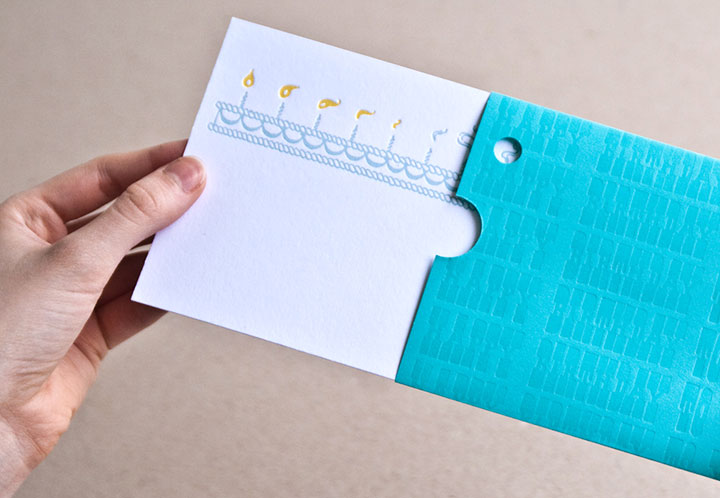
If you’ll happen to be there (either as an exhibitor or with a guest pass), say hello to Allison for me—she’ll be in booth 1550. The National Stationery Show runs from May 16 to 19, at the Javits Center on West 34th Street.
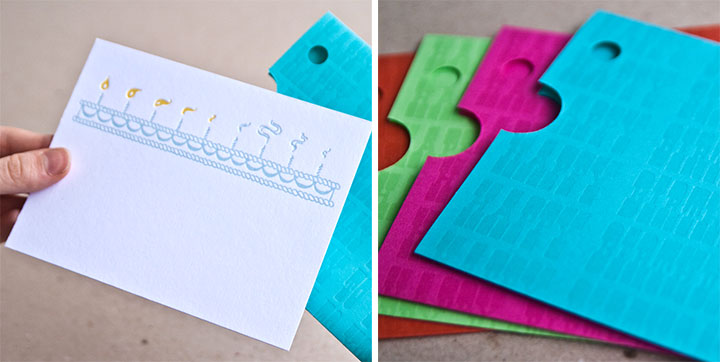
Best of luck, Allison!
May 9th, 2010
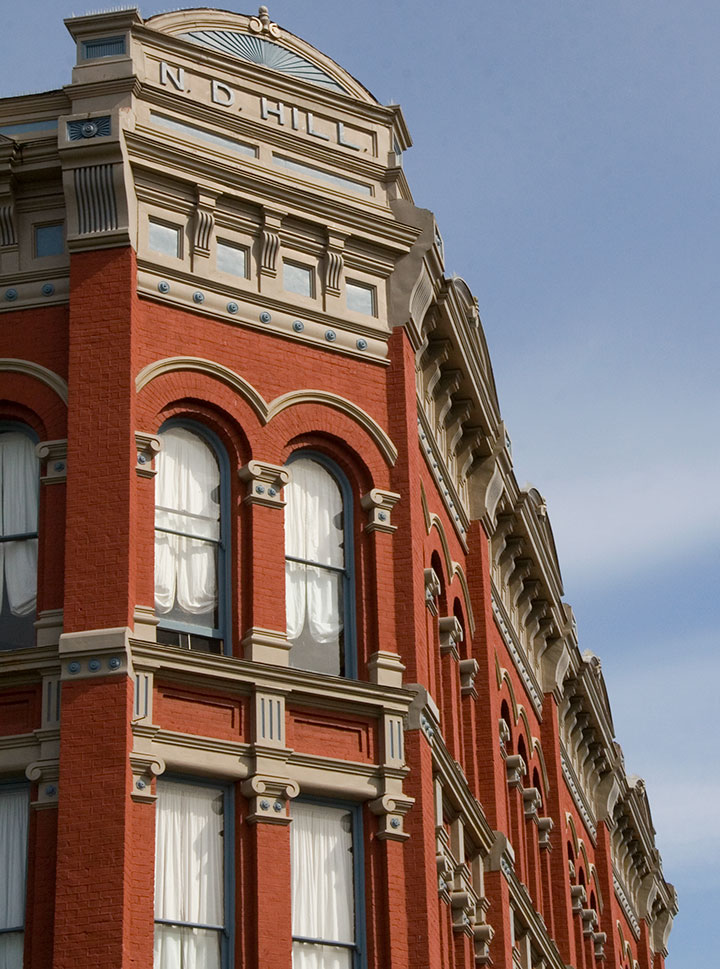
Today was just begging for a Sunday drive, Mother’s Day crowds be darned, so the Tailor and I moseyed up to another of my favorite haunts: Port Townsend.
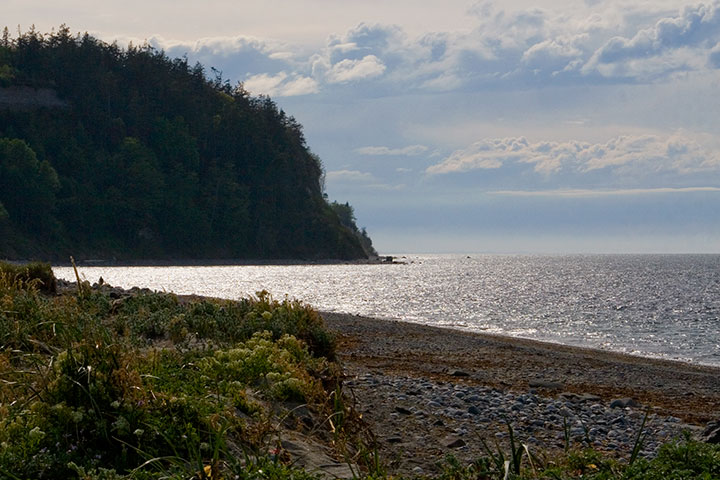
Port Townsend is located on the northeastern tip of the Olympic Peninsula (close on a map to but in reality very far from Cape Flattery) and guards Admiralty Inlet, where Puget Sound ends and the Straits of Juan de Fuca begin. It’s practically within shouting distance of Canada on one side (you can just make out the line of Vancouver Island along the horizon here), and lava-spewing range of Mt. Baker on another.
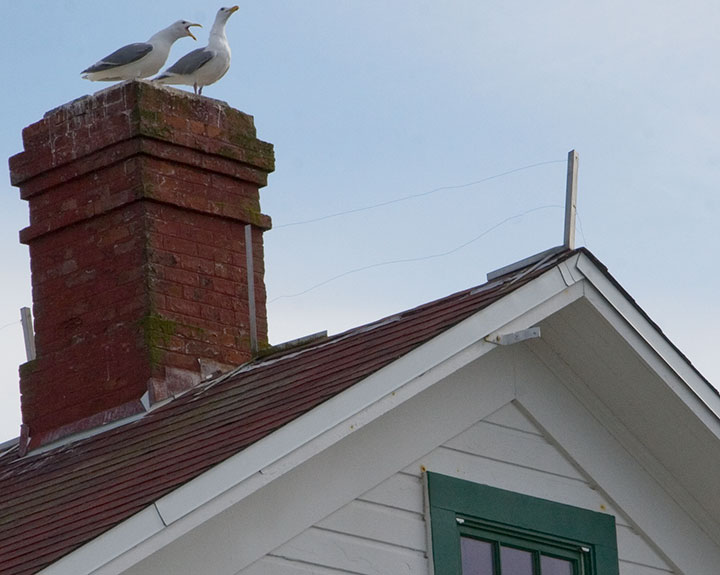
These days it’s a sleepy, semi-tourist town (thankfully it’s remote enough that it’s often possible to go without being mobbed by teeming hordes), home to both artists and seagulls, but at one time this place was hoppin’.
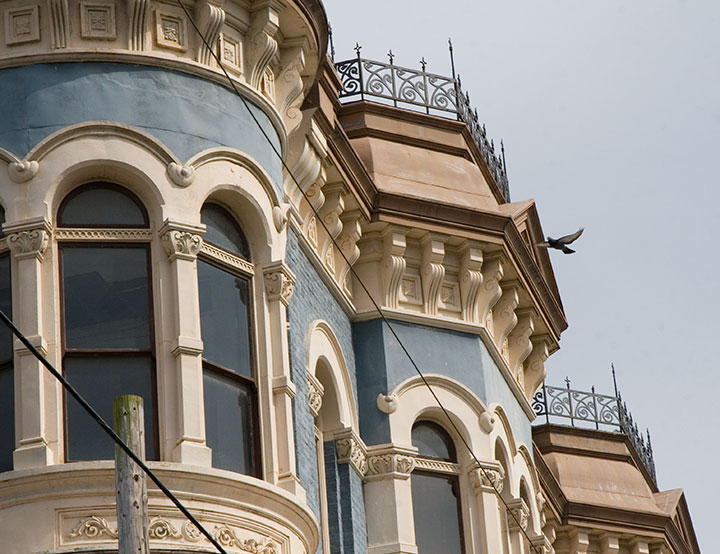
Its location made it an ideal military, trade, and shipping hub; Port Townsend was a prosperous and well-established seaport by the 1870s—nearly twenty years before Washington became a state. The town’s early boom afforded it a lavish and significant array of Victorian architecture—and once shipping fell out of favor there, its failure to develop a replacement industry (see above: remote) proved to be an accidental blessing of historical preservation. As a result, Port Townsend has an astonishing collection of Victorian houses and commercial buildings, and is one of only three seaports on the National Register of Historic Places.
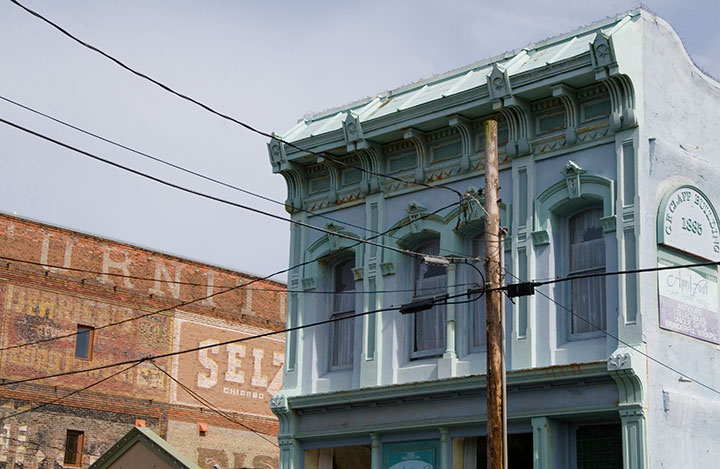
Beyond the architecture (which, don’t get me wrong, is the stuff of my dreams), what I love about this place is how lived-in it feels. It’s not a stage set, or an overgrown museum, like so many historic towns I’ve seen. Port Townsend feels comfortable, inviting, and absolutely real.
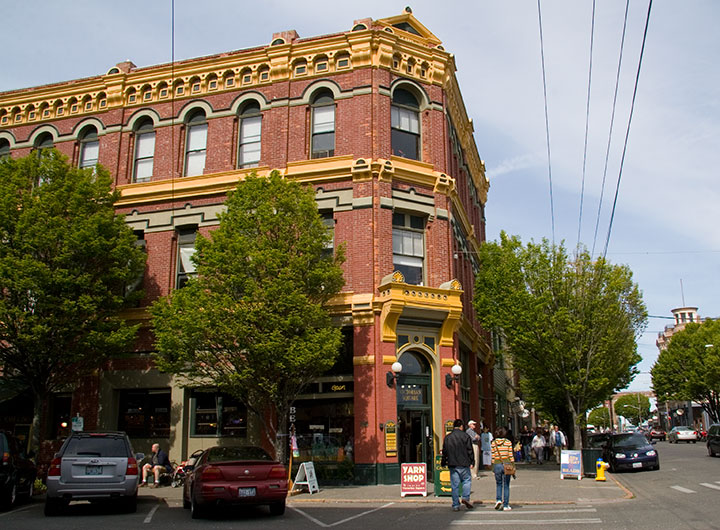
It reminds me of places like Durango, Colorado; Stillwater, Minnesota; Salem, Massachusetts—all places that have taken up permanent residency in my heart. Places with real, breathing history and still-current ordinary life.
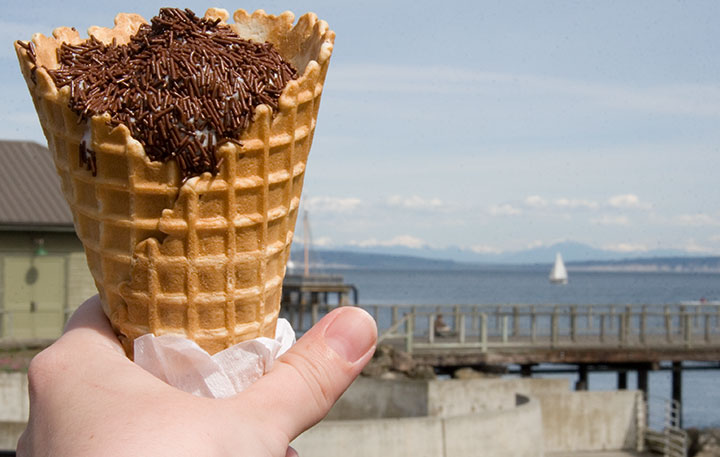
And I’m not even biased by the New England-authentic jimmies-coated ice cream cone I stumbled upon today—though the pitch-perfect nostalgia of my favorite childhood treat favorite-thing-in-the-whole-wide-world (which really can’t be found west of the Hudson, at least not completely slathered like this, and for which I nevertheless search tirelessly) made me happier than I can say.
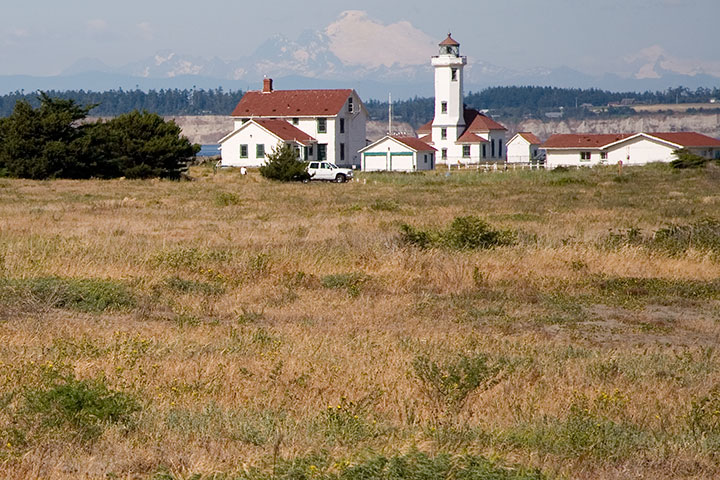
Ahem. I digress. Big time. Port Townsend has one more beauty up its sleeve—although as it’s not on the beaten path, it’s easy to miss. The tippy-tip of the town’s little peninsula is occupied by Fort Worden, formerly an army installation (1890s to 1953) and now a state park. The gub’mint knew what it was doing with this one—they picked one of the loveliest and most strategically important chunks of real estate in the Pacific Northwest. I’m sure glad it belongs to all of us now—I think it’s better for flying kites than cannonballs anyway.
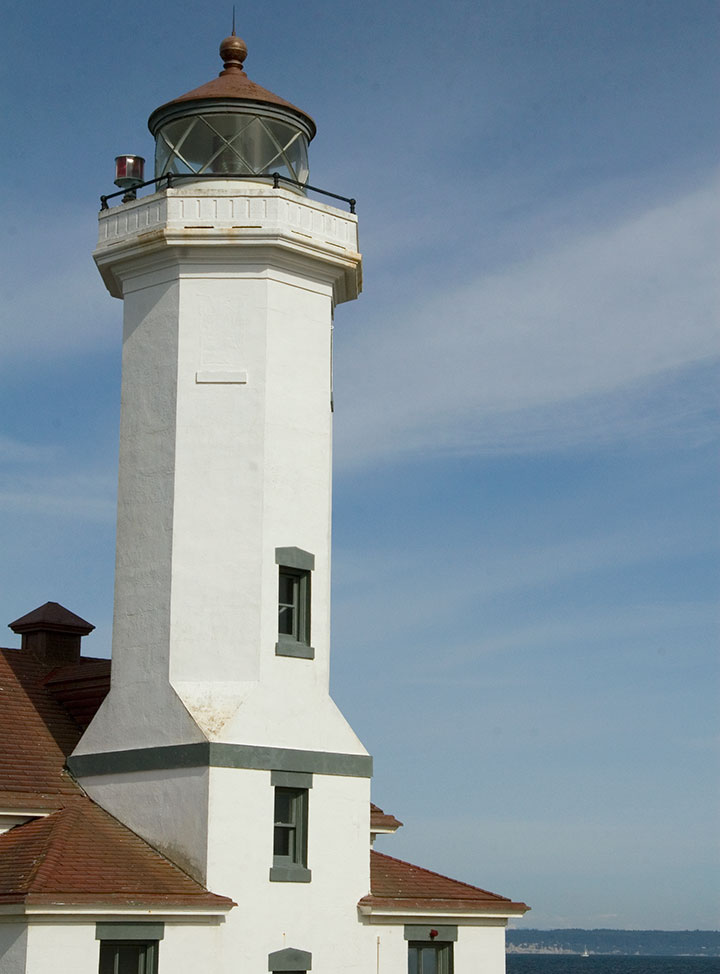
Fort Worden’s best feature, and the perfect climax to a day in Port Townsend, is Point Wilson Light, the tallest lighthouse on the Sound. This is one of my favorite spots to sit and watch the world go by, and today’s date reminded me that while we didn’t get to it on her recent visit, this is one spot that I think my mum would love, too.
Happy Mother’s Day, everyone! (And happy birthday, Dad!)
May 2nd, 2010
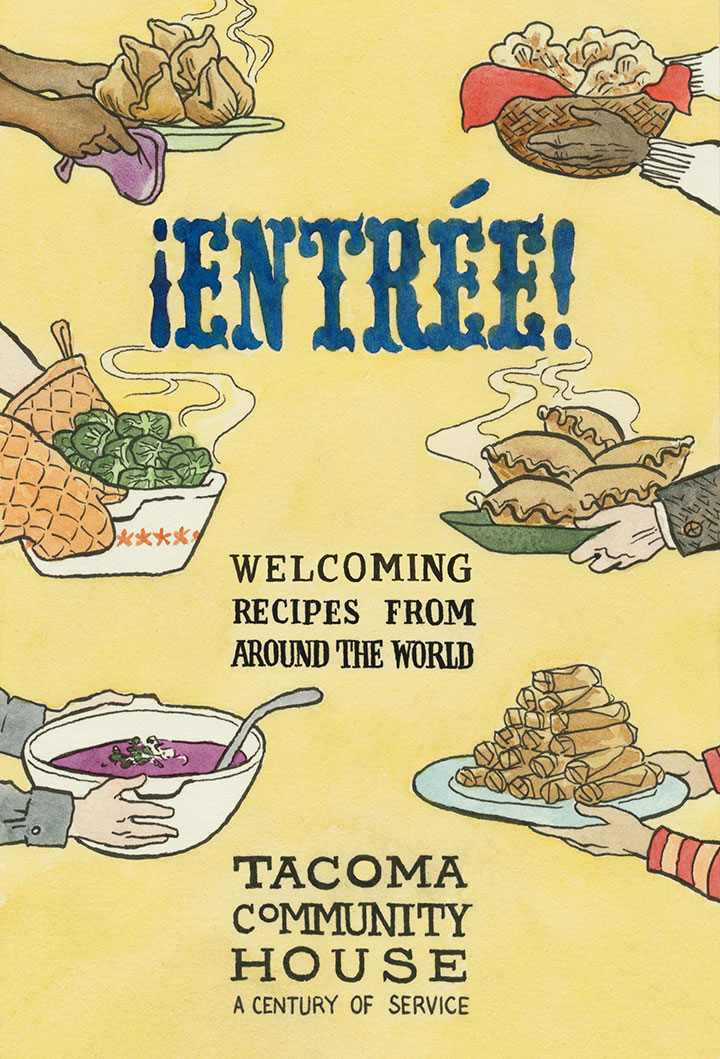
I think it’s time to get that new wok I’ve been meaning to buy, because I have a feeling it’s going to get a lot of use. The cookbook I illustrated is now available, and I can’t wait to give it a whirl.
Tacoma Community House has been serving Tacoma’s immigrant community for decades, offering an enormous range of educational and social services to its clients—including language translation and interpretation, job training, citizenship assistance, and employment programs. The diversity of clients is astounding—in the last year alone, TCH served clients from fifty-four countries. To bring their clients together and welcome them to the community, TCH has a tradition of holding potluck dinners. As a result, they’ve compiled an impressive collection of international recipes over the years. In honor of their 100th anniversary this year (can you believe that?), TCH has compiled a collection of their favorites into a cookbook: ¡Entrée!
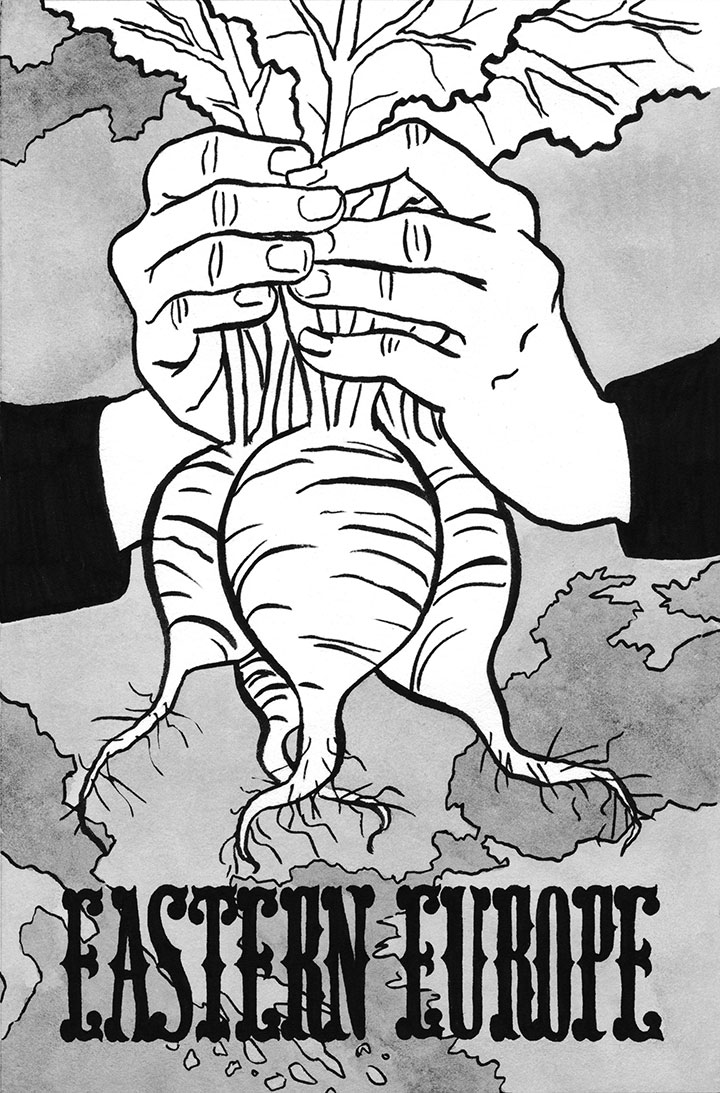
I have a feeling they had quite a job of editing; ¡Entrée! contains over 140 recipes from five world regions. Even the name is a play on this diversity, combining the inverted exclamation point from Spanish with a French term.

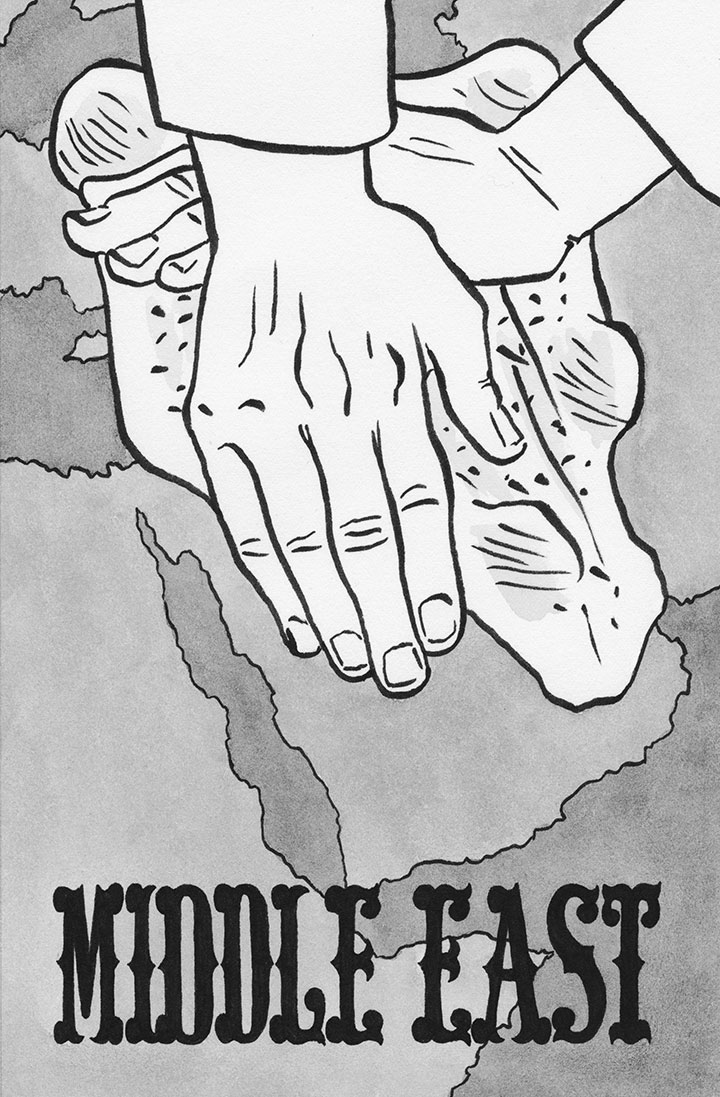
Dishes represented here include empanadas, tabouli, spring rolls, moussaka, samosas, gazpacho, cottage pie, a wide range of curries, and even American Indian fry bread.
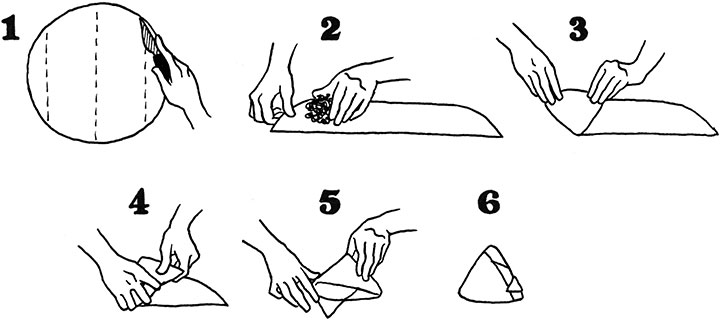
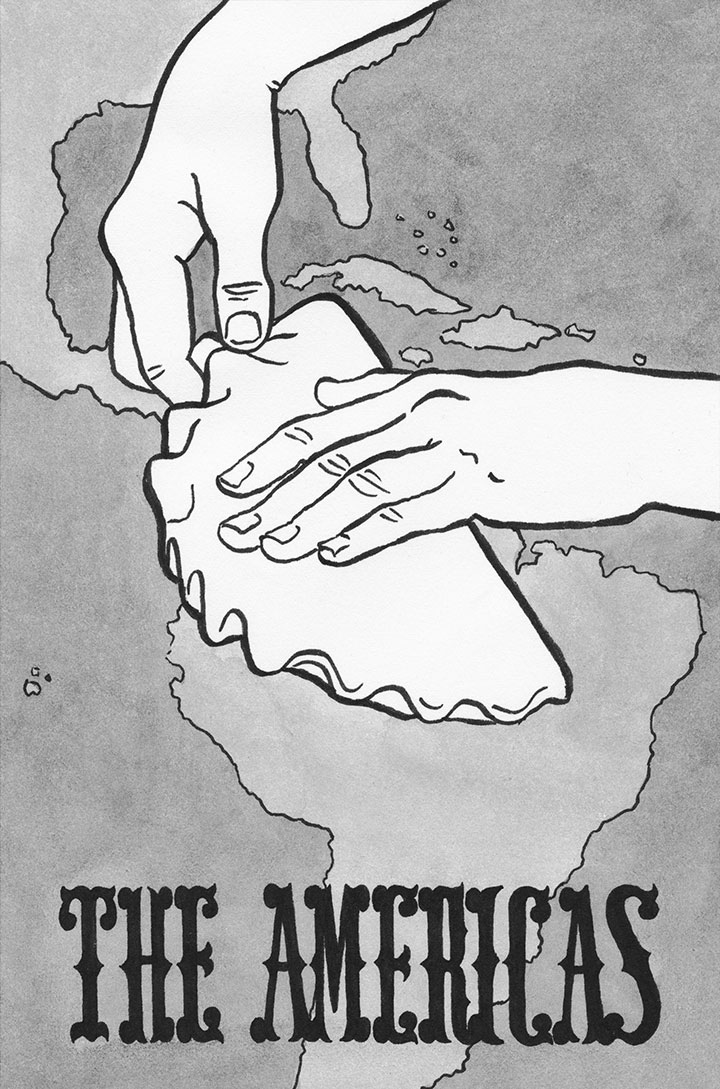
To bring all these recipes together into a cohesive theme, all the illustrations focused on hands—which came in handy for the step-by-step instructions.
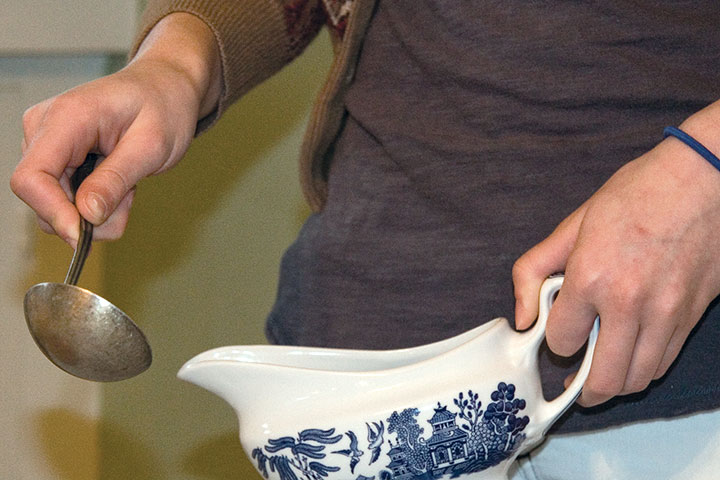
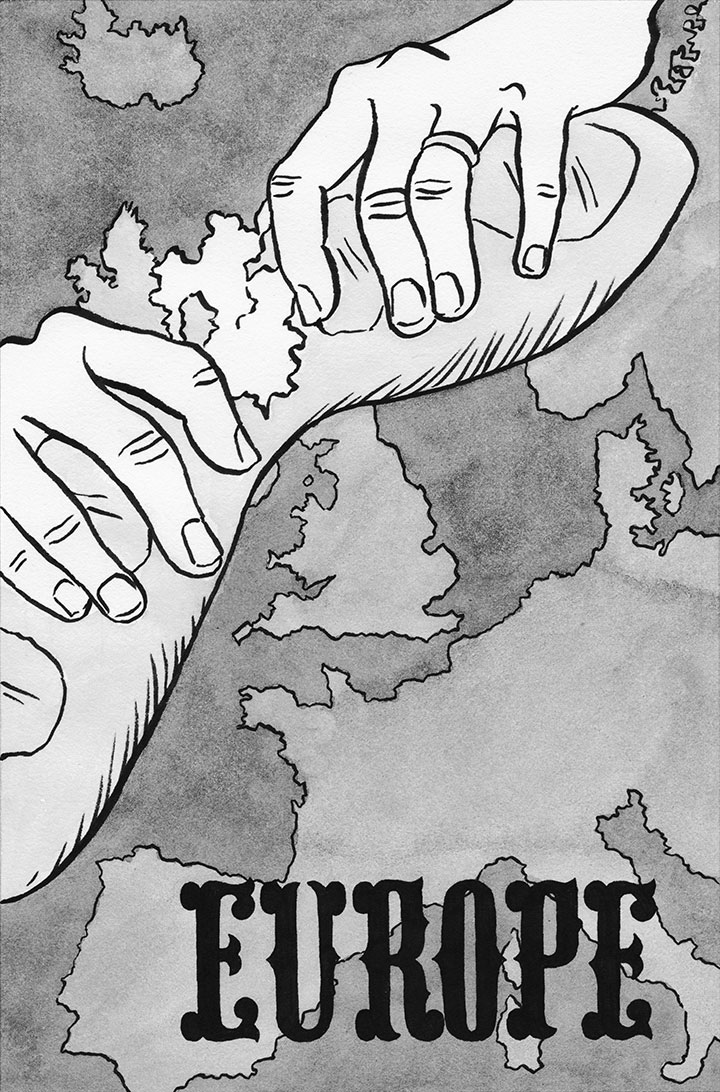
(Hence all the hand-modeling by Zooey.)
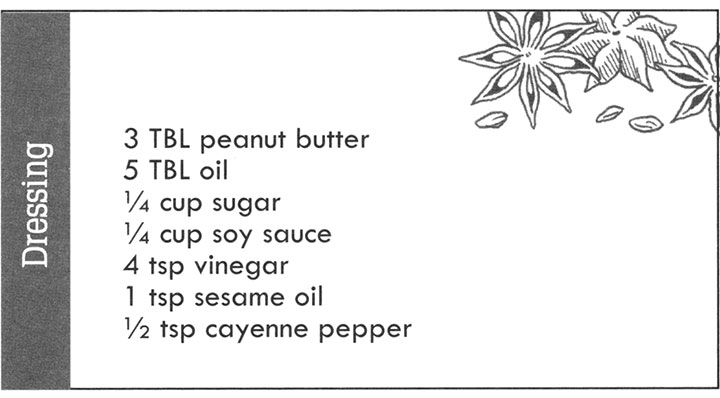
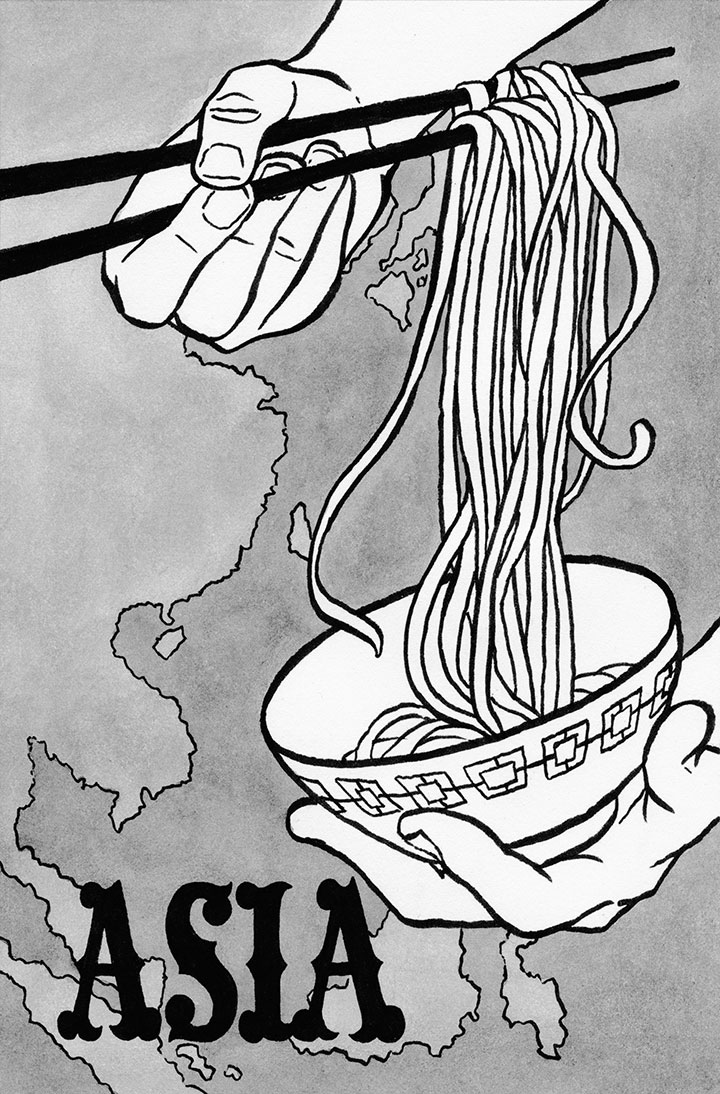
Each recipe is as authentic as it gets—instead of being filtered through some chef or ethnic restaurant, these dishes come directly from the family traditions of TCH’s clients. They even passed the Tailor test (and he has high standards!)—no processed ingredients, no store-bought shortcuts, no mention of canned cream-of-mushroom soup. He even gave the English plum pudding recipe (which is one of his specialties) his stamp of approval.
I think I’ll be trying this one first:
Arroz Mexicano (Mexican Rice)
1/2 cup tomato sauce
1/2 cup water
2 green onions, chopped
2 cloves garlic, chopped
1/4 tsp salt
2 Tbsp lard or cooking oil
1 cup long grain rice
Tip: It’s important in Mexican rice to fry the rice before you add the liquids. It will make a difference in the texure and taste.
1. Mix tomato sauce and water together; add green onions, garlic and salt to the tomato sauce.
2. Heat lard or oil in a sauce pan on medium-high heat; add the rice and cook till slightly brown.
3. Add tomato sauce mixture and lower the heat; add more water of the mixture does not cover the rice. Cover and let simmer for about 20 minutes or until liquid is gone from the pan.
4. Lard is used by many Mexican families for cooking instead of cooking oils.
Oh, and about the lard: heck, yes. If you’ve ever tried refried beans at an authentic Mexican restaurant, the lard is what makes it taste so good. Don’t be afraid—a little lard won’t kill you. Go ahead and try it! Learn it, love it, lard it.
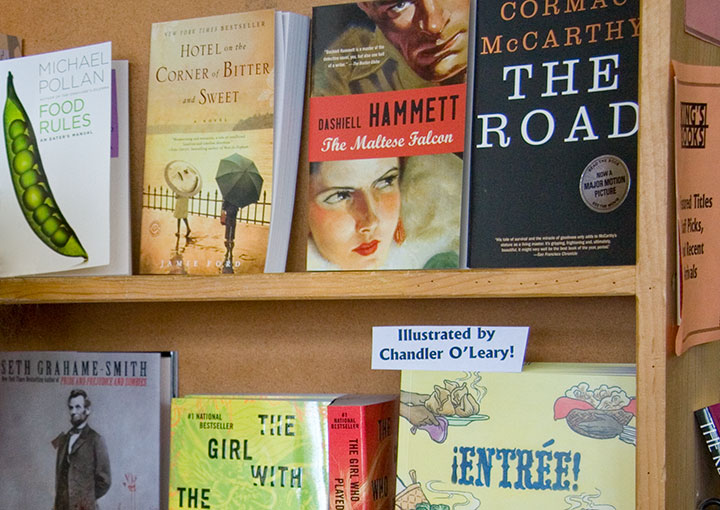
I loved working with TCH (and with Hana K., their talented designer, who treated my illustrations with such care), but even better was seeing ¡Entrée! on a bookstore shelf. You can find a copy in town at King’s Books, or you can try more sample recipes and order online here.

April 28th, 2010
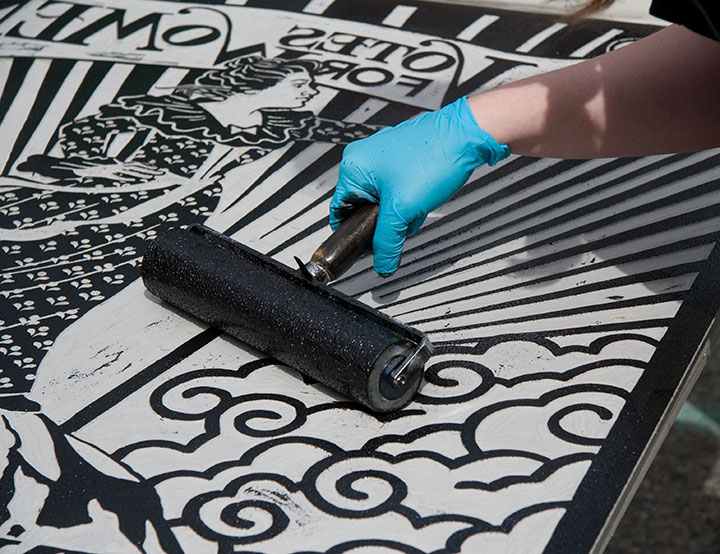
Inked up,
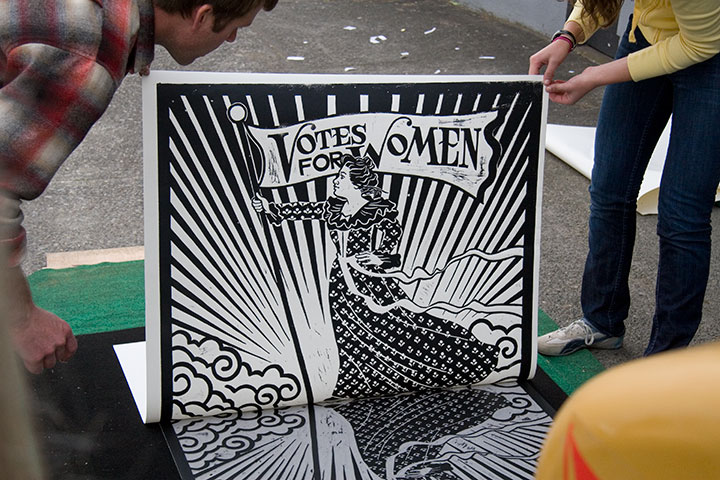
hand-pulled,
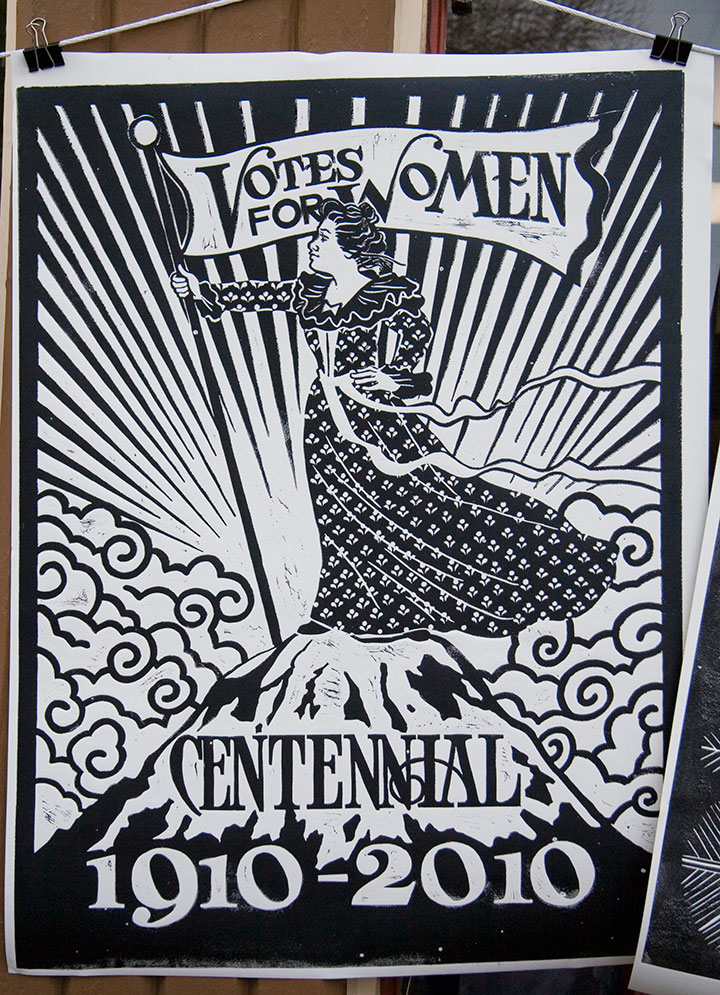
and voilà! Our second collaborative steamroller print, an unofficial Dead Feminist, inspired by Cora Smith Eaton King, who in 1909 climbed Mt. Rainier with a party of Seattle Mountaineers and placed a “Votes for Women” banner at the summit.

This year’s Wayzgoose was the biggest bash yet! We had all the regulars—
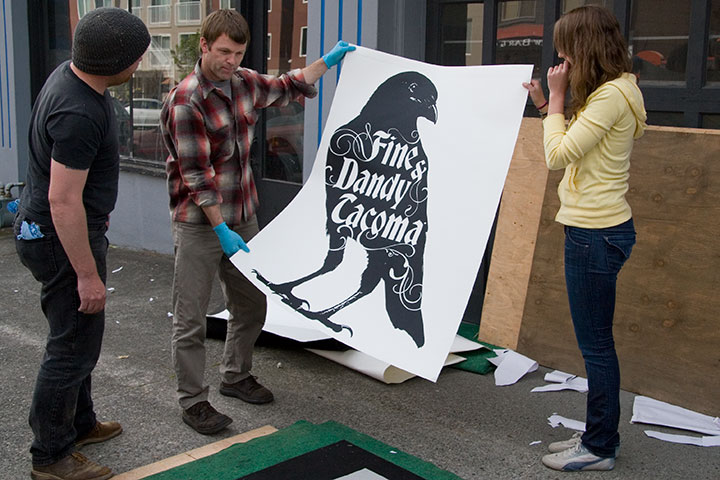
who churned out perfection under pressure (no pun intended)—
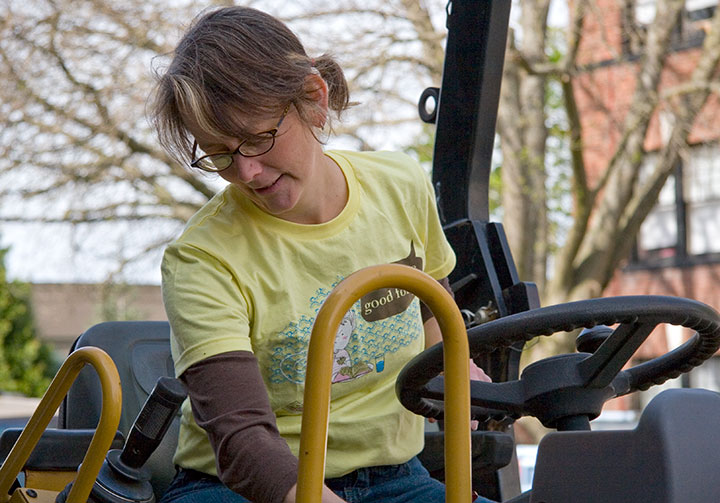
our beloved ringleader,

a certain befezzed flavor,

and a whole host of newcomers to round out the experience.
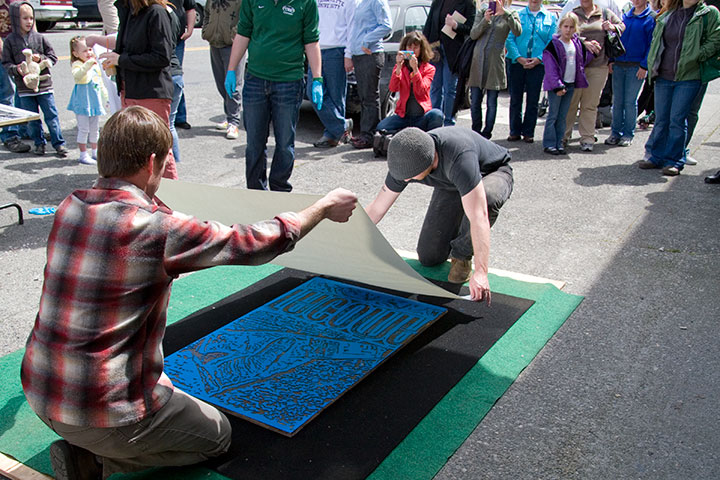
We had an enormous crowd (thank goodness for the good weather!),
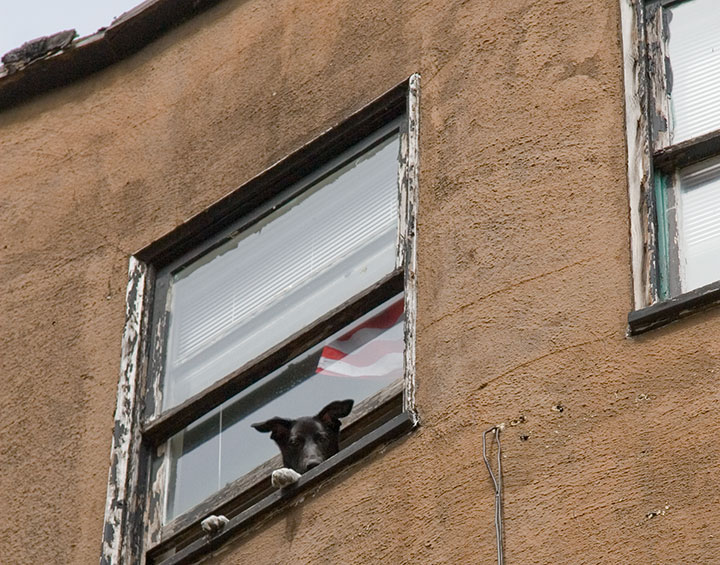
and even a few unexpected audience members.
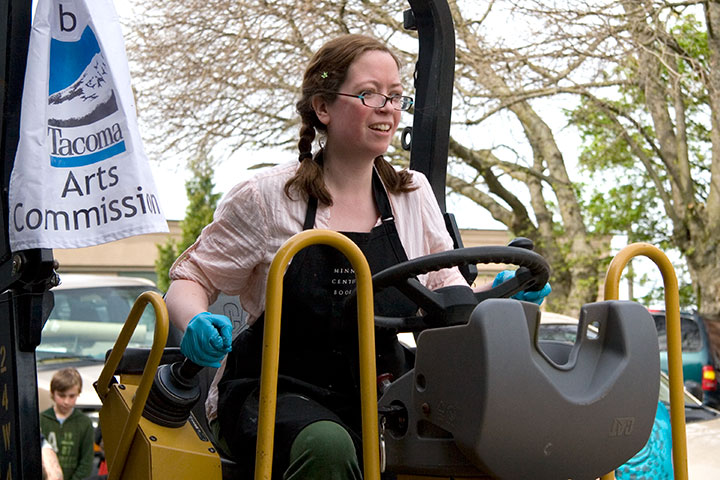
This year I got to try my hand at driving the steamroller,

but I think pretending was plenty enough for this little guy.
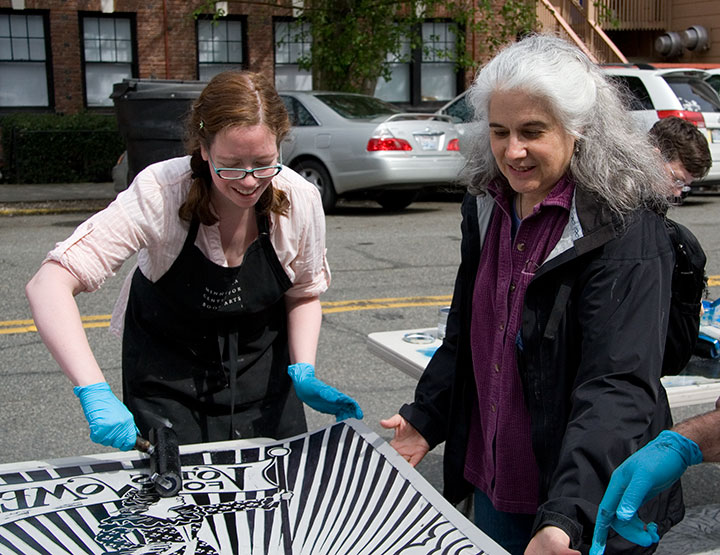
Thanks to everybody who stopped by to say hello, or stuck around to lend a helping hand.

And of course, a huge bucket of gratitude to the Tacoma Arts Commission for making it all happen!
One more acknowledgement: photography by Michael O’Leary. Thanks, Dad!
April 18th, 2010
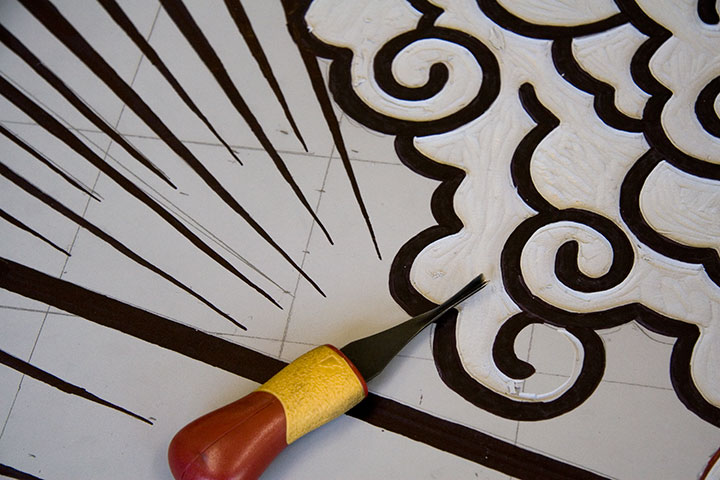
Jessica and I are carving like mad this week, getting ready for some quality steamroller time.
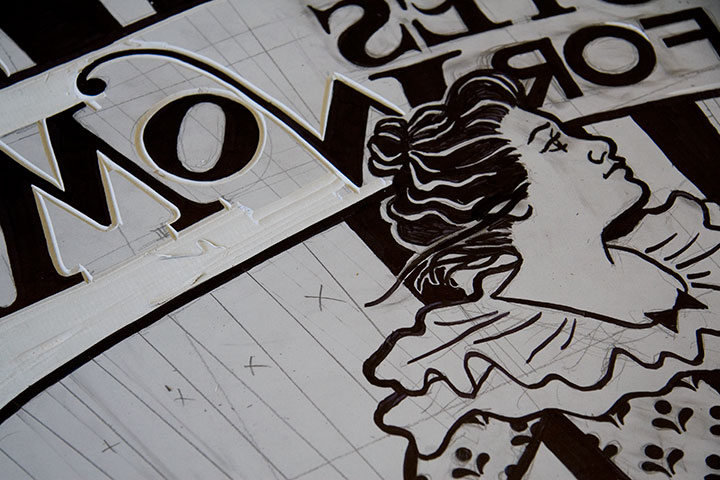
Next Sunday, April 25, is the sixth-annual Wayzgoose at King’s Books, right here in Tacoma. This year promises to be the biggest hullabaloo yet, with letterpress magnetic poetry, B.Y.O. t-shirt printing, papermaking demos, artist tables, and the star of the show: steamroller printing! Last year over 500 people came to check it out, despite a torrential downpour—and this year, the weather just might promise to behave, so we’re bracing for a mob. There’s a reason for the crowds: this is a heckuva lot of fun. Here’s the skinny:
6th Annual Wayzgoose!
Sunday, April 25, 2010
Noon to 4 pm
Free!
King’s Books
218 St. Helens Ave., Tacoma
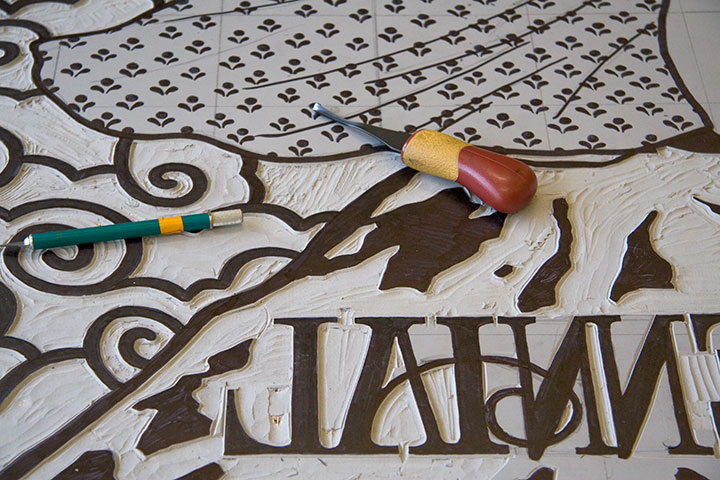
Eight artists and artist-teams will be printing gigantic three-by-four-foot linocuts in the street, including Jessica and me—we’ll be adding another unofficial Dead Feminist to our roster. (Take a gander at our last steamroller print here.) This is just a sneak peek; stop by next Sunday to see this block in action.
See you there!
April 12th, 2010
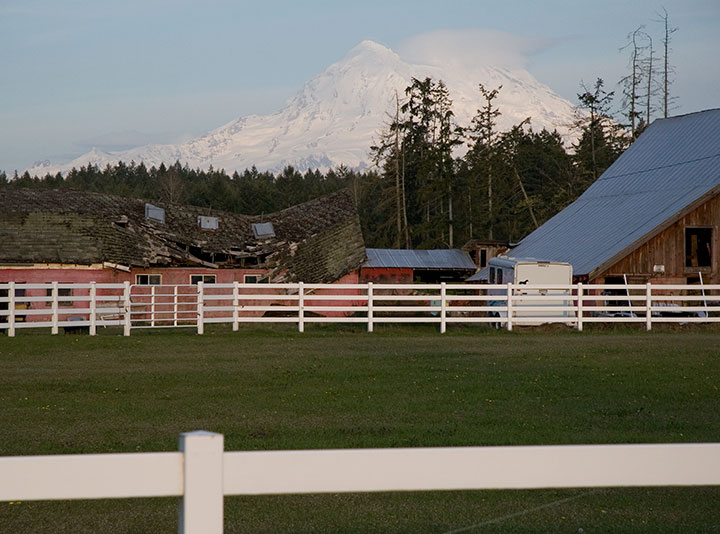
The sun came out yesterday afternoon, and Mt. Rainier peeked out from behind the clouds. On a whim I tossed my camera into the car and bolted to Paradise, where I had been hoping for one more research shot for my book: Rainier in the snow.
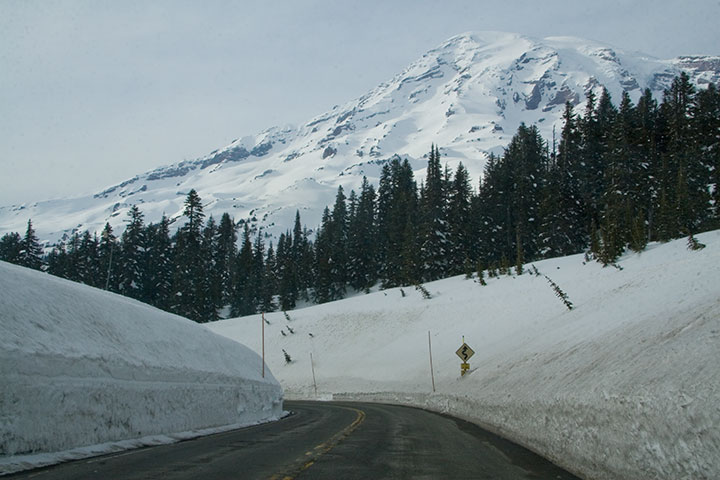
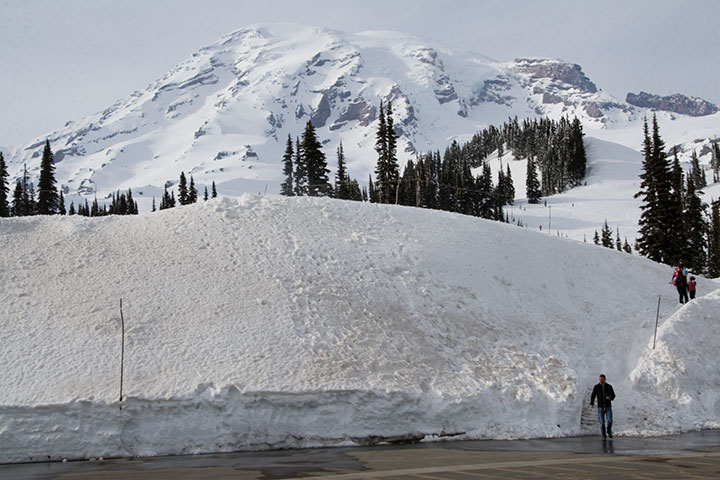
Well, I certainly got my wish.
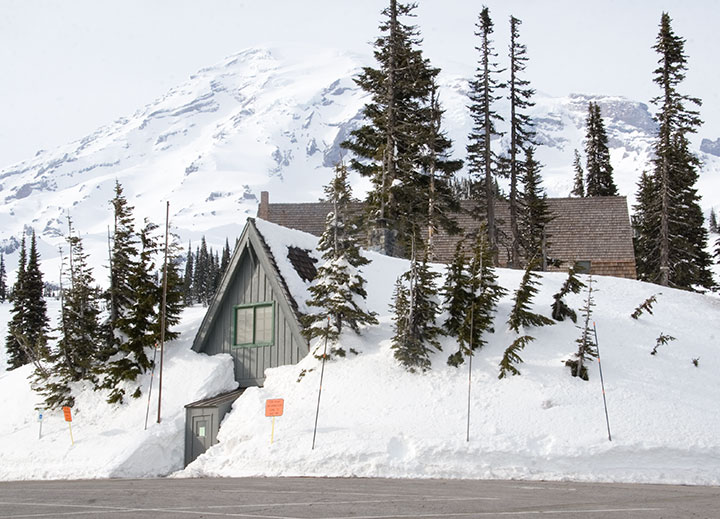
An hour and a half later I was standing in the cold, at the highest point on the southern park road, and the furthest one can go before the snow melts at the end of June and the rest of the park opens.

I looked over at one of the few cars around me, and was absurdly reminded of all those winters I spent in North Dakota (minus the mountains, of course).
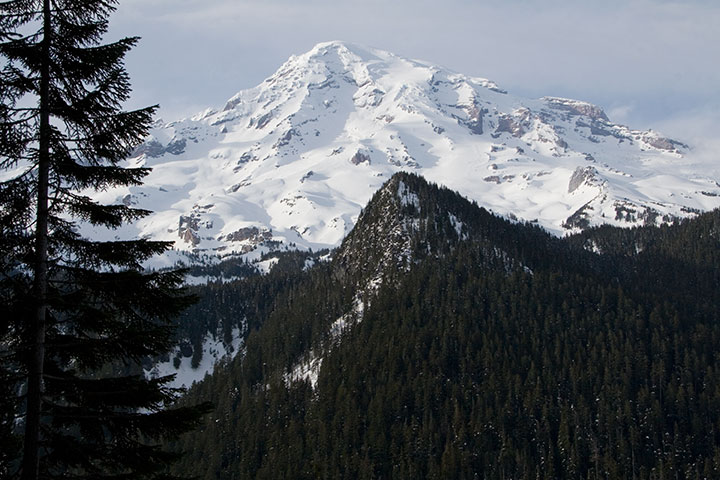
It was nice to think that if I wanted snow, I could come and get it whenever I wanted—without having to shovel my way out of it.
April 7th, 2010
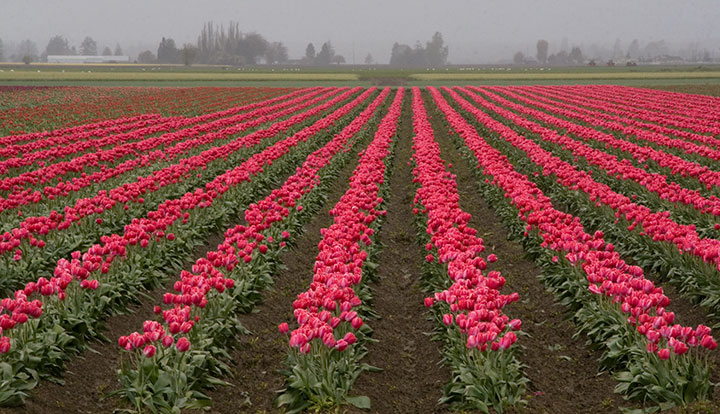
Yesterday I headed north with a friend for my second Skagit Valley Tulip Festival. I was hoping to do some drawing this year, but the weather had other plans.
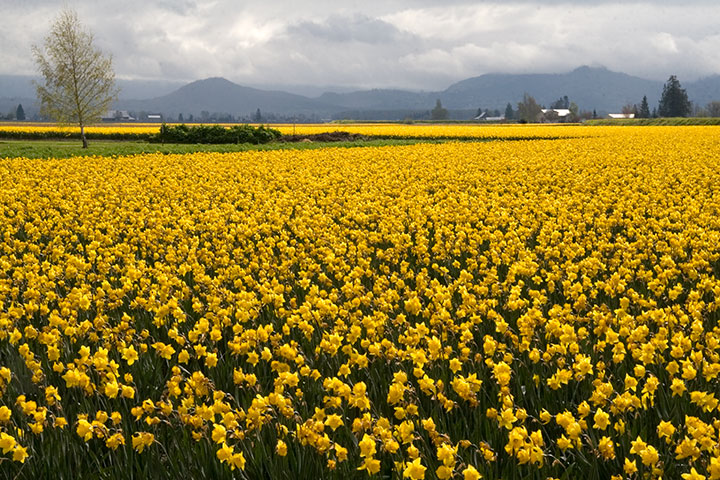
It was like I’d never been there before—everything was different this year. For one thing, the tulips are blooming early, so the daffodils hadn’t retired yet.

For another, the farmers have rotated their crops, so the tulips are occupying different fields than last year—which gave me a whole new set of photo possibilities.
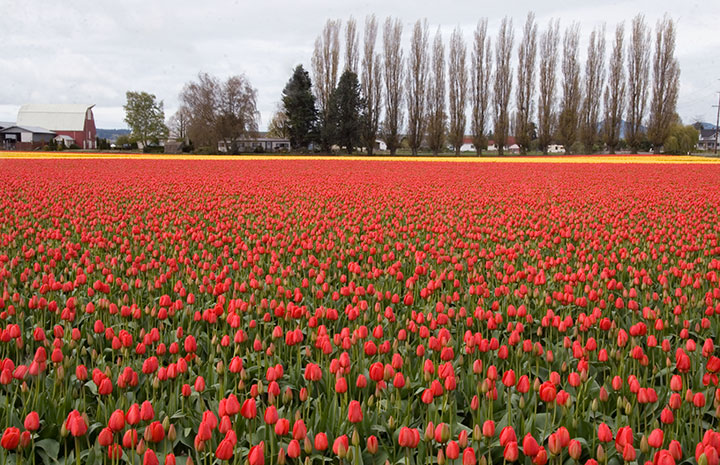
And best of all, we had the place to ourselves—Tuesday discouraged the tourists with day jobs, and the rain took care of the rest.

The Skagit Valley is quickly becoming a favorite haunt; it was hard not to turn the day trip into a week of following all the back roads and exploring all the hidden pockets of scenery I discovered yesterday.
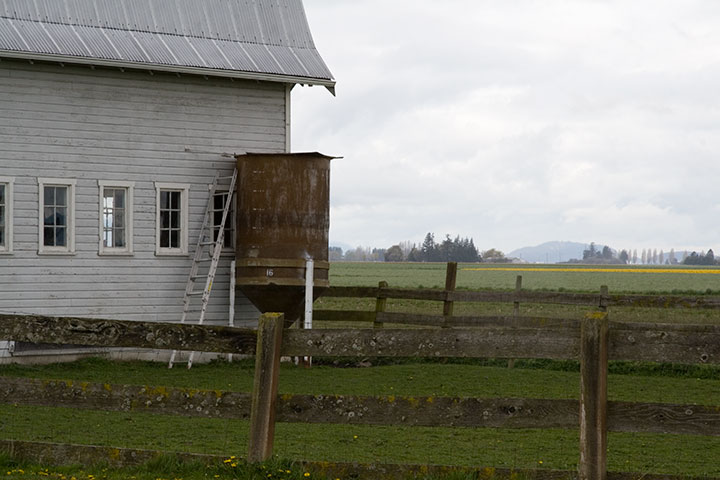
That’s okay, though. I know that next time, more than just tulips will be waiting for me.
March 31st, 2010
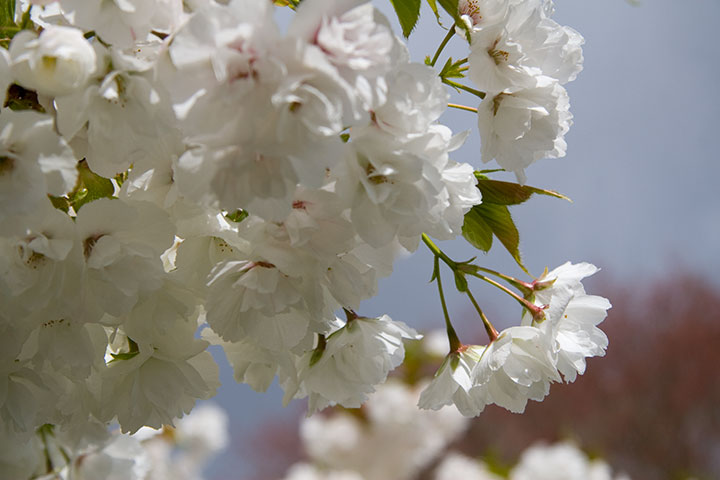
Normally I’m an autumn kind of gal, but I have to say that spring might just be the best season in the Northwest. There’s something spectacular around every corner.
March 22nd, 2010
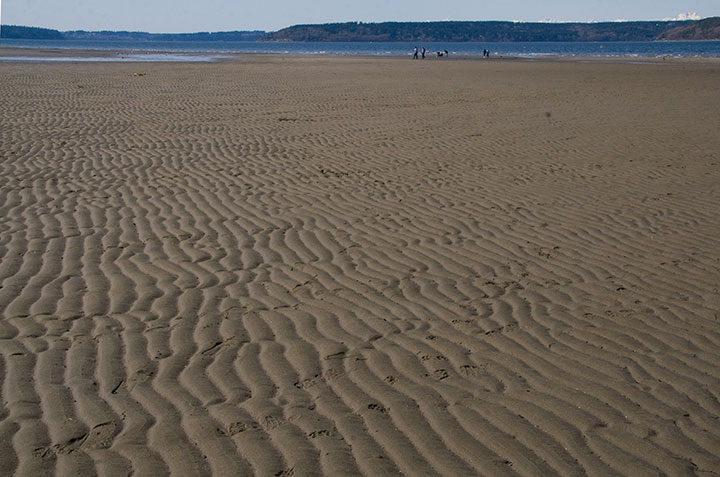
For the most part, Puget Sound is extremely deep, and lined with narrow, rocky beaches, with steep drop-offs and underwater cliffs. But Dash Point is one place where, at low tide, you can walk a long, long way out on a pristine sandbar. I love the feeling of standing out in the middle of a drained basin, just steps away from the familiar but suddenly in a whole different world.






![Chandler O'Leary [logo]](https://chandleroleary.com/wp-content/themes/chandleroleary/images/logo.png)























































